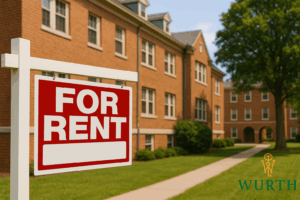
Would you pay extra for convenience? Your future tenants might. Furnished rentals sound like an easy way to charge more, but is it really worth the effort? More importantly, will your furniture survive long enough to make it a profitable decision?
Offering a fully furnished rental has its perks. You attract a different kind of tenants such as business travelers, students, and short-term renters who don’t want the hassle of moving furniture. But the flip side? Higher start-up costs, potential damage, and the occasional tenant who treats your couch like a trampoline. So, should you do it? Let’s break it down.
The Case for Furnished Rentals
1. Higher Rent = Higher Income
This is the biggest reason landlords go furnished. A fully equipped unit can command 20-30% more rent than an unfurnished one. You’re offering a move-in-ready space, and tenants will pay for that convenience.
Example: Say an unfurnished apartment rents for $1,500 per month. A furnished version could go for $1,950 or more. Over a year, that’s an extra $5,400 in revenue which is more than enough to cover the cost of a basic furniture package.
2. Attract a Unique Tenant Pool
Furnished rentals appeal to people who need flexibility. Think:
- Corporate travelers who are in town for a few months
- Graduate students who aren’t settling long-term
- Medical professionals on temporary contracts
- People in transition (divorced, relocating, or between home purchases)
These tenants often take good care of the property because they’re professionals or individuals in life transitions and not party-seeking college students (usually).
3. Easier to Market and Fill Vacancies Faster
Have you ever walked into an empty apartment and struggled to imagine how it would look furnished? Your potential tenants feel the same way. A well-staged, furnished unit looks better in photos and helps renters visualize themselves living there.
Bonus: If you target traveling professionals, you can list them on sites like Airbnb or Furnished Finder, attracting renters willing to pay a premium.
The Downsides You Need to Consider
1. The Initial Cost is No Joke
Furniture isn’t cheap. Even budget-friendly options can add up quickly when buying an entire unit.
Example: Outfitting a one-bedroom unit with basic furniture can cost $3,000 to $6,000. That includes a bed, couch, dining set, and essentials like lamps and a TV. High-end rentals? You’re looking at $10,000+. And it doesn’t stop there. You’ll need to replace and update items as they wear out.
2. Damage and Wear Are Real Concerns
Tenants don’t always treat furniture as their own. Sofas get stained, beds break, and coffee tables double as footrests. The wear and tear on a furnished unit is higher than on an unfurnished one, meaning more frequent replacements.
Solution? Invest in durable, easy-to-clean furniture. Leather couches, stain-resistant fabrics, and metal or solid wood frames will last longer than fragile alternatives.
3. Furnished Units Can Mean Shorter Leases
Because many furnished rentals cater to temporary tenants, you may face higher turnover rates. More turnover means more cleaning, advertising, and potentially more gaps between tenants, which can cut your profits.
That’s not always bad if you price accordingly, but it’s something to consider before diving in.
How to Protect Your Investment
If you’re worried about damage or loss, here’s how to safeguard your furnished rental:
- Charge a higher security deposit. Clearly outline in the lease that furniture damage beyond normal wear will be deducted.
- Create an itemized inventory. List every piece of furniture and its condition. Have tenants sign off on it at move-in.
- Opt for long-lasting materials. Stay away from glass tables and light-colored fabrics.
- Consider rental insurance. Some landlords require tenants to carry renters’ insurance that covers damage to furnishings.
Who Should Consider Furnishing Their Rentals?
Furnished rentals aren’t for every landlord. They make sense if:
- Your property is in an area with high demand for short-term stays (business districts, university towns, hospitals, or tourist hubs).
- You’re targeting a higher-income tenant pool that values convenience.
- You don’t mind a higher initial investment in exchange for potentially higher returns.
If you prefer stable, long-term tenants and lower maintenance, an unfurnished rental might be better.
Where Do New Orleans Property Managers Fit In?
New Orleans is a prime market for furnished rentals. Demand is strong with a constant flow of business travelers, medical professionals, and even film industry workers needing short-term housing. As property managers in NOLA, we have mastered the art of balancing furnished and unfurnished units to maximize returns while minimizing risk.
If you’re a landlord considering furnished rentals in New Orleans, working with a local property manager can help you understand and succeed in the market. At Wurth Property Management we know what renters expect, how to price competitively, and how to handle the logistics so you don’t have to.
Final Takeaway
Furnished rentals can be a smart investment, but they require strategy. Suppose you’re willing to handle the higher costs and occasional furniture mishaps. The extra income and tenant flexibility can make it all worthwhile in that case. If not, sticking to an unfurnished model might save you a few headaches.
Either way, knowing your market is key. And in a city like New Orleans, furnished rentals might just be the edge you need.






